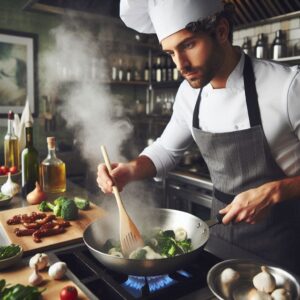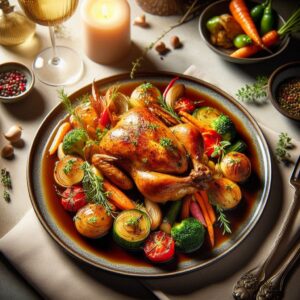5214.0402 Techniques for Making Gelées
Gelées are an exquisite and versatile component in modern cuisine, providing both visual appeal and a unique texture that enhances the overall dining experience. These transparent, jelly-like structures can be sweet or savory, ranging from delicate fruit-based jellies to hearty, flavorful aspics made from reduced broths or stocks. The key to crafting perfect gelées lies in mastering the techniques of using gelling agents like gelatin, agar-agar, or natural pectins, ensuring the ideal hydration, consistency, and flavor balance. Understanding the science behind the setting process and applying it with precision allows chefs to elevate the presentation and flavor profiles of their dishes.
In this chapter, we will explore the techniques involved in making gelées, including the hydration and proper use of gelling agents, controlling set times and consistency, and the artistry of layering gelées for visual appeal. These techniques not only enhance the texture and presentation but also offer opportunities for creating multi-dimensional flavor experiences. The ability to balance sweetness, acidity, and color while ensuring perfect consistency will allow any gelée, from dessert jellies to savory aspics, to shine with elegance.
Techniques for Making Gelées
Creating the perfect gelée requires attention to detail in several areas: the correct use of gelling agents, controlling set times, layering for visual complexity, and balancing flavors. Each of these techniques plays a crucial role in achieving the desired texture and appearance of the gelée, whether it’s a sweet dessert or a savory dish. Let’s explore the essential steps for crafting perfect gelées.
Hydration and Proper Use of Gelling Agents
One of the most important steps in making gelées is understanding how to properly hydrate and use the gelling agent. Gelatin, agar-agar, and natural pectins are the most common gelling agents, each requiring specific methods for activation and dissolution. Hydration is essential to ensure that the gelling agent dissolves completely and sets correctly.
- Gelatin:
Gelatin needs to be hydrated in cold water before it is dissolved into a warm liquid. This process, known as “blooming,” allows the gelatin to absorb water and swell, making it easier to dissolve into the hot liquid. If gelatin is added directly to hot liquids without blooming, it may form lumps and fail to dissolve properly. Once bloomed, gelatin is dissolved by gently warming the liquid (never boiling) and can then be added to the other ingredients.- Tips for Hydrating Gelatin:
- Always use cold water to hydrate gelatin before adding it to any liquid.
- Avoid overheating gelatin once dissolved, as excessive heat can degrade its gelling properties.
- Tips for Hydrating Gelatin:
- Agar-Agar:
Agar-agar requires boiling to dissolve, unlike gelatin, which dissolves at lower temperatures. It is important to bring the mixture to a boil and maintain this temperature for a few minutes to fully dissolve the agar before adding it to the other components. Agar sets at room temperature and has a much firmer texture than gelatin.- Tips for Using Agar-Agar:
- Boil the agar-agar mixture for a minimum of 2-3 minutes to ensure it dissolves completely.
- Agar-agar requires less liquid than gelatin for setting, so adjustments may be needed to achieve the desired consistency.
- Tips for Using Agar-Agar:
- Pectins:
Pectins are commonly used in fruit gelées, and their ability to set liquids depends on the sugar content and acidity of the fruit. Natural pectins are activated by heat and require the right balance of sugar and acid to form a firm gel. In commercial applications, pectin can also be added as a powder or liquid concentrate to achieve consistent results.- Tips for Working with Pectin:
- Ensure the fruit has enough natural acid to activate the pectin.
- Adjust the sugar content to achieve the desired texture.
- Tips for Working with Pectin:
Controlling Set Times and Consistency
Once the gelling agent has been incorporated, controlling the set time and consistency is crucial. Gelées need time to set properly, and the temperature must be carefully managed during the setting process. This section focuses on how to control both the time it takes for a gelée to set and the consistency of the final result.
- Set Times:
Different gelling agents have varying setting times, and understanding this is essential to prevent over-setting or under-setting the gelée. Gelatin takes a few hours to set at refrigerator temperature, whereas agar-agar sets at room temperature much more quickly. Therefore, it’s important to time the setting process correctly to avoid altering the texture.- Tip for Controlling Set Times:
- Plan for the gelée to cool completely, either at room temperature or in the refrigerator, depending on the gelling agent used.
- Tip for Controlling Set Times:
- Consistency:
The consistency of the gelée is also influenced by the concentration of gelling agent used. Too much gelatin or agar-agar can create a rubbery texture, while too little will result in a runny gelée. Experimenting with the ratio of liquid to gelling agent is important for achieving the right balance.- Tip for Achieving Ideal Consistency:
- Test the gelée after the initial setting time by gently pressing on it to check if it has reached the desired firmness.
- Tip for Achieving Ideal Consistency:
Layering Gelées for Visual Appeal
Layering gelées not only adds visual interest to a dish but can also enhance the flavor profile by offering multiple complementary layers of flavor. This technique requires precision in timing and temperature, as the gelées must be allowed to set partially before adding subsequent layers to prevent them from blending.
- Aspic-Style Gelées:
Aspic-style gelées typically feature savory layers of flavored broth or stock. These gelées often include vegetables, herbs, or meats suspended within the gelée, creating a beautiful and complex visual presentation. To achieve this, each layer must be carefully poured and allowed to set before the next layer is added. This process requires patience and precision to ensure that each layer is clear and distinct.- Tips for Layering Gelées:
- Allow each layer to set fully before adding the next one to prevent bleeding or mixing of colors.
- Use a slightly warmer liquid for subsequent layers to prevent disturbing the lower layers.
- Tips for Layering Gelées:
Precision in Hydrating and Dissolving Gelatin or Natural Pectins
Precision in hydration and dissolving the gelling agents ensures that the gelée has the perfect texture and clarity. Overheating gelatin or under-dissolving agar-agar or pectin can lead to inconsistent results, making the gelée too firm, too runny, or cloudy.
- Gelatin and Agar-Agar Precision:
The exact temperature required to dissolve gelatin or agar-agar is essential to achieving the desired gel consistency. Using too high a temperature can degrade the gelling properties, while too low a temperature may cause incomplete dissolution. Measuring temperatures carefully and following the specific instructions for each gelling agent will result in the best texture and clarity.- Tip for Precision:
- Always use a thermometer to monitor the temperature of the liquid when dissolving gelling agents, especially for agar-agar.
- Tip for Precision:
Layering Techniques for Visual and Flavor Complexity
Layering gelées offers a chance to create multi-layered flavor and textural experiences. By using different flavored gelées or creating visual depth, chefs can elevate their dishes and provide guests with a complex, memorable experience.
- Flavor Complexity:
Layering different flavors in gelées allows for a nuanced experience, as each layer can offer a different taste. For example, a savory gelée made from stock can be paired with a sweeter fruit gelée, offering contrasting flavors that work well together.- Tip for Flavor Complexity:
- Consider the overall dish when layering gelées—sweet and savory flavors should complement, not overpower, each other.
- Tip for Flavor Complexity:
Balancing Sweetness, Acidity, and Color for Elegant Results
Balancing sweetness, acidity, and color is essential for creating an aesthetically pleasing and flavorful gelée. For sweet gelées, the fruit’s acidity should be balanced with sugar to avoid a too-sweet or overly tart gelée. The color of the gelée is also important, as it enhances the visual appeal of the dish.
- Sweetness and Acidity Balance:
In fruit gelées, the natural sweetness and acidity of the fruit must be considered when determining the amount of sugar to add. A gelée made from overly sweet fruit may need additional acid, such as lemon juice, to provide balance.- Tip for Balancing Flavors:
- Taste the gelée mixture before setting it, adjusting sugar or acid as needed for the perfect flavor balance.
- Tip for Balancing Flavors:
Four Recommendations for Restaurant Industry
- Experiment with Layering Gelées: Layering gelées can add significant visual appeal and complexity to dishes. Experiment with different flavors and textures to create unique presentations.
- Master Precision with Gelling Agents: Ensure that gelatin, agar-agar, or pectin is hydrated and dissolved properly to avoid texture issues in the final product.
- Balance Flavors Carefully: Always taste the gelée mixture before setting it to ensure the right balance of sweetness, acidity, and flavor concentration.
- Use Gelées to Enhance Presentation: Incorporate gelées as decorative elements in plated dishes, offering both aesthetic beauty and complementary flavors.
Mastering the techniques for making gelées is a valuable skill for any chef, as it offers endless opportunities for creativity in both sweet and savory dishes. The careful selection and proper hydration of gelling agents, along with controlling set times, consistency, and flavor balance, allow chefs to create gelées that elevate the texture, appearance, and taste of their dishes. Layering gelées adds further complexity and elegance, transforming a simple dish into a work of art. By perfecting these techniques, chefs can create memorable dining experiences that delight guests with both flavor and visual appeal.


